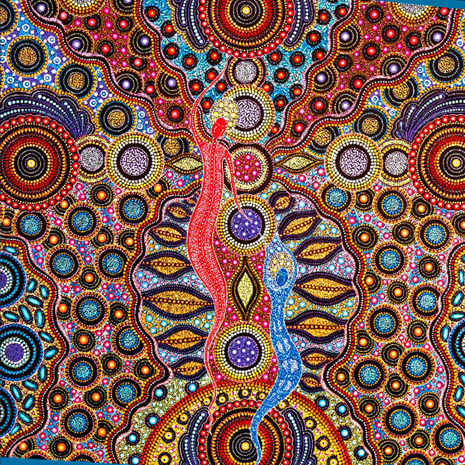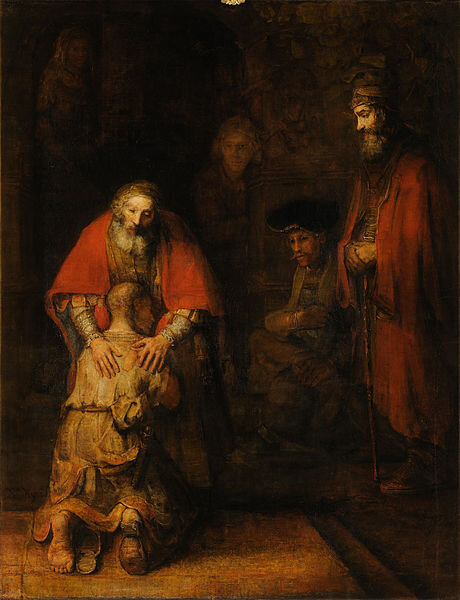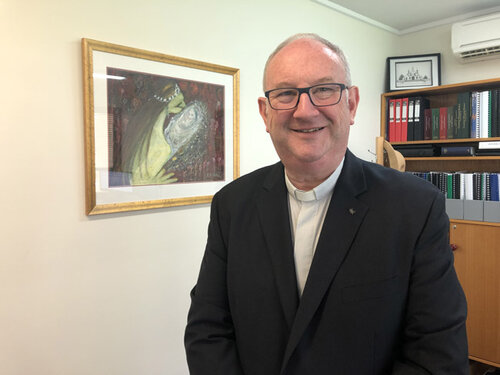The evangelising power of Christian art - Stephen Hackett MSC

Jesus said nothing about art. He did, however, speak using images that were at once familiar enough to be grasped and yet evocative enough to provide a glimpse of the mystery about which he was speaking – God, the Kingdom, the Temple, the Cross, eternal life.
The Church, from early times, turned to art in its life, worship and mission. Art, in the form of figurative and symbolic images, was used to portray or signify important people, places and events in the Christian story. Art, in images of the Scriptures, the saints and history was used to catechise. Art, in churches and other sacred places, was used in a sacramental way to make present and to honour those whose images were portrayed – Christ crucified, the Virgin Mary, biblical figures and the saints.
Across the centuries and across cultures, art has connected Christians of every generation with the story of salvation in Jesus Christ in which they participated in their own time and place. Art has heralded new beginnings and, after periods of darkness, given rise to a fresh impetus to rebuild the Church and to evangelise anew. And art has faced challenges – from iconoclasts who wanted to rid the Church of images and, in our own time, from those who regard art as a commodity to be traded or exhibited but not as a bearer of meaning, or of beauty, or of Christian culture or of the mysteries of faith.
Just as the printed word requires a certain literacy to be intelligible, so, too, does art. The more Christian symbolism is embedded a work of art, the greater the artistic literacy that is needed to comprehend the meaning of the artwork. Yet art cannot be limited to what is immediately comprehensible, for the beauty of art is first apprehended, speaking as it were to the spirit rather than to the mind.
This is one way in which art serves to evangelise, as the encounter with art draws forth a person’s deeper desire or longing, which one way or another is for the transcendent “other” whom we know to be God.
In this way, art evangelises by prompting or impelling someone to see, to recognise what, or actually who, it is that they are longing for. The beauty that is experienced in the encounter with art is of the essence in this process of evangelisation, as beauty transforms us by touching us so profoundly as to effect conversion. Pope Saint John Paul II explained as much in his Letter to Artists of 1999, where he wrote:

The Return of the Prodigal Son, by Rembran(d)t Harmenszoon van Rijn, c. 1669.
Beauty is a key to the mystery and a call to transcendence. It is an invitation to savour life and to dream of the future. That is why the beauty of created things can never fully satisfy. It stirs that hidden nostalgia for God which a lover of beauty like Saint Augustine could express in incomparable terms: “Late have I loved you, beauty so old and so new: late have I loved you!”.
Another way in which art evangelises is by capturing the attention of the Catholic imagination, which is incarnational, and so open to expression via artistic media. It isn’t an escape from what is real into fantasy. Rather, it can open the way by which a person engages with what is real in a deeper, more profound sense, drawing a person beyond what is seen to all that is beyond. Whether encountering a pious picture not regarded as having artistic merit or a work of art recognised for its greatness, the Catholic imagination makes present what is signified. Rembrandt’s The Return of the Prodigal Son and the depiction of the Divine Mercy inspired by St Faustina’s vision of Jesus in 1931 each draw the viewer beyond the image to the mercy of God revealed in Jesus Christ.
The Catholic imagination relies on Christian remembrance, which serves to evoke the story of salvation in Jesus Christ as attested to in Scriptures and celebrated in the liturgy. It manifests an openness to the revelation of God in Jesus and in history.
The home of the Catholic imagination is the Church, because the home of the Scriptures and the liturgy is the Church. The Catholic imagination does not spring from philosophy or theology – though it may be studied within these disciplines – and even less from the realm of abstract ideas, but from faith lived in the communio of the Church.

Christ our Joy, painted by Amunda Gorey. Copyright: Australian Catholic Bishops Conference.
Lastly, art can be created to intentionally evangelise by encouraging people to reflect, pray and act. In this sense, art is not just illustrative but is formative. The painting entitled Christ Our Joy by Indigenous artist Amunda Gorey was commissioned for the Australian 2018 Year of Youth to evangelise by focusing attention on the call of Pope Francis to young people and the Church to “open new horizons for spreading joy”.
Art helps us transcend our horizons so that we “see” God in new ways, or at least in ways that seem new. Art takes us out of ourselves as well as leading us deep within ourselves to encounter afresh the mystery of God. Art touches us with its beauty and draws us to beauty’s source in Jesus Christ. Art evangelises.

Fr Stephen Hackett MSC is the General Secretary of the Australian Catholic Bishops Conference.
This article was published in The Bridge, the e-publication of the National Centre for Evangelisation.
Images: Supplied by Stephen Hackett MSC